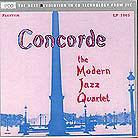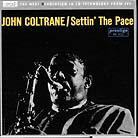| October 1998 ![[Reviewed on CD]](../format/regcd.gif) For me,
hearing the opening bars of "Ralph’s New
Blues" from the Modern Jazz Quartet’s Concorde
is like meeting an old friend on the street -- instant
recognition, even after all these years. I used to have Concorde
and John Coltrane’s Settin’ the Pace on
vinyl along with a drove of other Prestige titles (no
originals) and Verve super-quiet Japanese pressings. It
seems like ancient history, but I can vividly remember my
last turntable -- a Michell Gyrodec with Micro Seiki
tonearm and Shure V15V MR cartridge. I kept this setup
longer than I should have, not for its sound (which my
current digital setup easily surpasses) but because of
the great jazz I had on vinyl. For me,
hearing the opening bars of "Ralph’s New
Blues" from the Modern Jazz Quartet’s Concorde
is like meeting an old friend on the street -- instant
recognition, even after all these years. I used to have Concorde
and John Coltrane’s Settin’ the Pace on
vinyl along with a drove of other Prestige titles (no
originals) and Verve super-quiet Japanese pressings. It
seems like ancient history, but I can vividly remember my
last turntable -- a Michell Gyrodec with Micro Seiki
tonearm and Shure V15V MR cartridge. I kept this setup
longer than I should have, not for its sound (which my
current digital setup easily surpasses) but because of
the great jazz I had on vinyl.
These JVC CDs, the first
two in JVC’s XRCD2 series of audiophile remasters,
are gems -- mostly because of the care that JVC has
lavished on them. Thanks to the XRCD2 process, neither of
these recordings sounds 40 years old (but both are).
Although on Concorde John Lewis’ piano work
is still obscured by the resonant playing of Milt Jackson
on vibes, the individual instrumental lines are easier to
follow overall, which is good for further study and
increased admiration of the performances, but not
essential to enjoyment. And there’s now a bottom
end, not one that will shake the foundation of your
house, but one that’s clear and discernible.
Overall, I get the strong impression while listening to
JVC’s version of Concorde that I’m
hearing this recording on its best day.
Settin’ the Pace
is vintage Coltrane. He’s with the Red Garland Trio
(which he recorded with a number of times), and although
the shortest tune is over seven minutes long, the cuts
have characteristic individuality and flow.
Coltrane’s playing twists and turns, raises musical
issues, then resolves them. Garland and crew are
sympathetic helpers, always recognizing whose recording Settin’
the Pace is. The bass solo on "I See Your Face
Before Me," for example, seems only to set the stage
for Coltrane’s reentrance. The sound here is great
given the age of the recording -- resolved yet a touch
sweet. I know one of the professed aims of JVC with the
XRCD/XRCD2 series is to bring analog-like sound to
digital, but these discs are far better than I remember
the vinyl being.
Concorde and Settin’
the Pace appeal to me for a number of reasons, not
the least of which is that they remind me that so little
jazz of equal quality and historical importance is
created today. But given the way that JVC modernizes the
sound on these two recordings, you have no reason not to
consider them. They have legs.
| So
What Exactly is the XRCD Process? An analog recording
selected for the XRCD program is first played
back on a custom-built deck through a specially
designed mastering console. To the extent that
polarity reversals, edit pops and other types of
problems can be remedied, they are corrected at
this stage.
The analog signal
is then fed into JVC's K2 A/D converter, where it
is translated into 20-bit digital words. The
digital information is re-generated through JVC's
Digital K2 and transferred to a Sony PCM-9000 in
its 20-bit form. The optical disk is then shipped
to a dedicated XRCD line in JVC's Yokahama, Japan
manufacturing facility for actual disc
production. At the plant, the optical disk is
played back through the same Digital K2 machine,
where the digital signal is "bit down"
to 16 bits, treated to another layer of K2
regeneration, and finally sent to the laser of
the glass cutter. These elaborate production
measures are designed in part to eliminate any
time-based jitter in the data stream.
JVC settled on the
conventional aluminum coating for the final disc
after conducting extensive gold vs. copper vs.
aluminum listening comparisons. Simply put, JVC
believes that aluminum sounds best. The final
product comes in a handsome bound cover with
liner notes and a detailed explanation of the
XRCD process. Missing is the standard
push-release clamp for holding the disc, which
instead rests in its own sleeve.
By the way, the
main difference between XRCD and XRCD2 discs is
that in the creation of the latter, Digital K2
regeneration is used during the mastering and
manufacturing processes.
...John Upton
jmu@soundstage.com
|
GO BACK TO:
|
 Modern Jazz Quartet - Concorde
Modern Jazz Quartet - Concorde John Coltrane- Settin'
The Pace
John Coltrane- Settin'
The Pace![[Reviewed on CD]](../format/regcd.gif) For me,
hearing the opening bars of "Ralph’s New
Blues" from the Modern Jazz Quartet’s Concorde
is like meeting an old friend on the street -- instant
recognition, even after all these years. I used to have Concorde
and John Coltrane’s Settin’ the Pace on
vinyl along with a drove of other Prestige titles (no
originals) and Verve super-quiet Japanese pressings. It
seems like ancient history, but I can vividly remember my
last turntable -- a Michell Gyrodec with Micro Seiki
tonearm and Shure V15V MR cartridge. I kept this setup
longer than I should have, not for its sound (which my
current digital setup easily surpasses) but because of
the great jazz I had on vinyl.
For me,
hearing the opening bars of "Ralph’s New
Blues" from the Modern Jazz Quartet’s Concorde
is like meeting an old friend on the street -- instant
recognition, even after all these years. I used to have Concorde
and John Coltrane’s Settin’ the Pace on
vinyl along with a drove of other Prestige titles (no
originals) and Verve super-quiet Japanese pressings. It
seems like ancient history, but I can vividly remember my
last turntable -- a Michell Gyrodec with Micro Seiki
tonearm and Shure V15V MR cartridge. I kept this setup
longer than I should have, not for its sound (which my
current digital setup easily surpasses) but because of
the great jazz I had on vinyl.